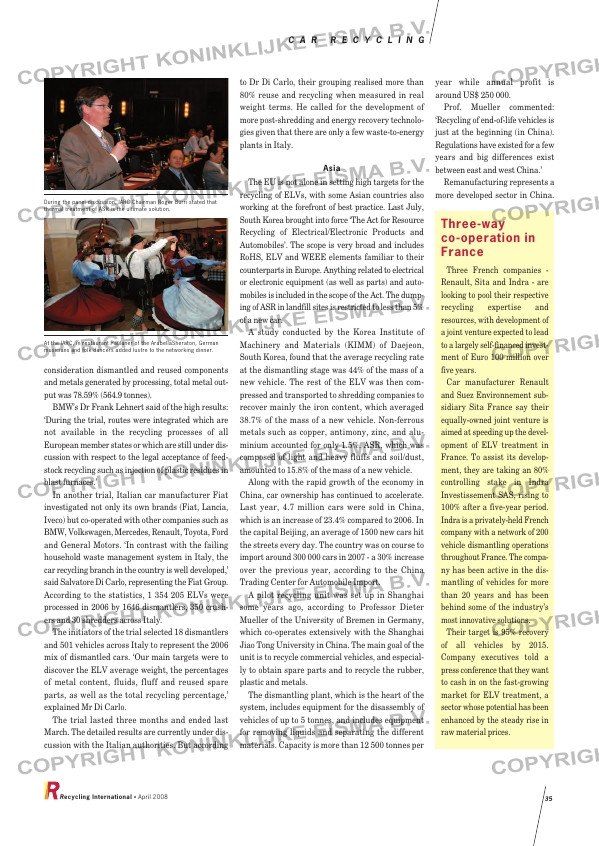Page 35 from: April 2008

consideration dismantled and reused components
and metals generated by processing, total metal out-
put was 78.59% (564.9 tonnes).
BMW’s Dr Frank Lehnert said of the high results:
‘During the trial, routes were integrated which are
not available in the recycling processes of all
European member states or which are still under dis-
cussion with respect to the legal acceptance of feed-
stock recycling such as injection of plastic residues in
blast furnaces.’
In another trial, Italian car manufacturer Fiat
investigated not only its own brands (Fiat, Lancia,
Iveco) but co-operated with other companies such as
BMW, Volkswagen, Mercedes, Renault, Toyota, Ford
and General Motors. ‘In contrast with the failing
household waste management system in Italy, the
car recycling branch in the country is well developed,’
said Salvatore Di Carlo, representing the Fiat Group.
According to the statistics, 1 354 205 ELVs were
processed in 2006 by 1646 dismantlers, 350 crush-
ers and 30 shredders across Italy.
The initiators of the trial selected 18 dismantlers
and 501 vehicles across Italy to represent the 2006
mix of dismantled cars. ‘Our main targets were to
discover the ELV average weight, the percentages
of metal content, fluids, fluff and reused spare
parts, as well as the total recycling percentage,’
explained Mr Di Carlo.
The trial lasted three months and ended last
March. The detailed results are currently under dis-
cussion with the Italian authorities. But according
C A R R E C Y C L I N G
Recycling International • April 2008 35
to Dr Di Carlo, their grouping realised more than
80% reuse and recycling when measured in real
weight terms. He called for the development of
more post-shredding and energy recovery technolo-
gies given that there are only a few waste-to-energy
plants in Italy.
Asia
The EU is not alone in setting high targets for the
recycling of ELVs, with some Asian countries also
working at the forefront of best practice. Last July,
South Korea brought into force ‘The Act for Resource
Recycling of Electrical/Electronic Products and
Automobiles’. The scope is very broad and includes
RoHS, ELV and WEEE elements familiar to their
counterparts in Europe. Anything related to electrical
or electronic equipment (as well as parts) and auto-
mobiles is included in the scope of the Act. The dump-
ing of ASR in landfill sites is restricted to less than 5%
of a new car.
A study conducted by the Korea Institute of
Machinery and Materials (KIMM) of Daejeon,
South Korea, found that the average recycling rate
at the dismantling stage was 44% of the mass of a
new vehicle. The rest of the ELV was then com-
pressed and transported to shredding companies to
recover mainly the iron content, which averaged
38.7% of the mass of a new vehicle. Non-ferrous
metals such as copper, antimony, zinc, and alu-
minium accounted for only 1.5%. ASR, which was
composed of light and heavy fluffs and soil/dust,
amounted to 15.8% of the mass of a new vehicle.
Along with the rapid growth of the economy in
China, car ownership has continued to accelerate.
Last year, 4.7 million cars were sold in China,
which is an increase of 23.4% compared to 2006. In
the capital Beijing, an average of 1500 new cars hit
the streets every day. The country was on course to
import around 300 000 cars in 2007 – a 30% increase
over the previous year, according to the China
Trading Center for Automobile Import.
A pilot recycling unit was set up in Shanghai
some years ago, according to Professor Dieter
Mueller of the University of Bremen in Germany,
which co-operates extensively with the Shanghai
Jiao Tong University in China. The main goal of the
unit is to recycle commercial vehicles, and especial-
ly to obtain spare parts and to recycle the rubber,
plastic and metals.
The dismantling plant, which is the heart of the
system, includes equipment for the disassembly of
vehicles of up to 5 tonnes, and includes equipment
for removing liquids and separating the different
materials. Capacity is more than 12 500 tonnes per
Three-way
co-operation in
France
Three French companies –
Renault, Sita and Indra – are
looking to pool their respective
recycling expertise and
resources, with development of
a joint venture expected to lead
to a largely self-financed invest-
ment of Euro 100 million over
five years.
Car manufacturer Renault
and Suez Environnement sub-
sidiary Sita France say their
equally-owned joint venture is
aimed at speeding up the devel-
opment of ELV treatment in
France. To assist its develop-
ment, they are taking an 80%
controlling stake in Indra
Investissement SAS, rising to
100% after a five-year period.
Indra is a privately-held French
company with a network of 200
vehicle dismantling operations
throughout France. The compa-
ny has been active in the dis-
mantling of vehicles for more
than 20 years and has been
behind some of the industry’s
most innovative solutions.
Their target is 95% recovery
of all vehicles by 2015.
Company executives told a
press conference that they want
to cash in on the fast-growing
market for ELV treatment, a
sector whose potential has been
enhanced by the steady rise in
raw material prices.
During the panel discussion, IARC Chairman Roger Burri stated that
thermal treatment of ASR is the ultimate solution.
At the IARC, in restaurant Paulaner of the ArabellaSheraton, German
musicians and folk dancers added lustre to the networking dinner.
year while annual profit is
around US$ 250 000.
Prof. Mueller commented:
‘Recycling of end-of-life vehicles is
just at the beginning (in China).
Regulations have existed for a few
years and big differences exist
between east and west China.’
Remanufacturing represents a
more developed sector in China.
RI_028 (IARC) Car recycling:Opmaak 1 04-04-2008 08:50 Pagina 35



